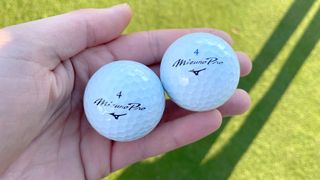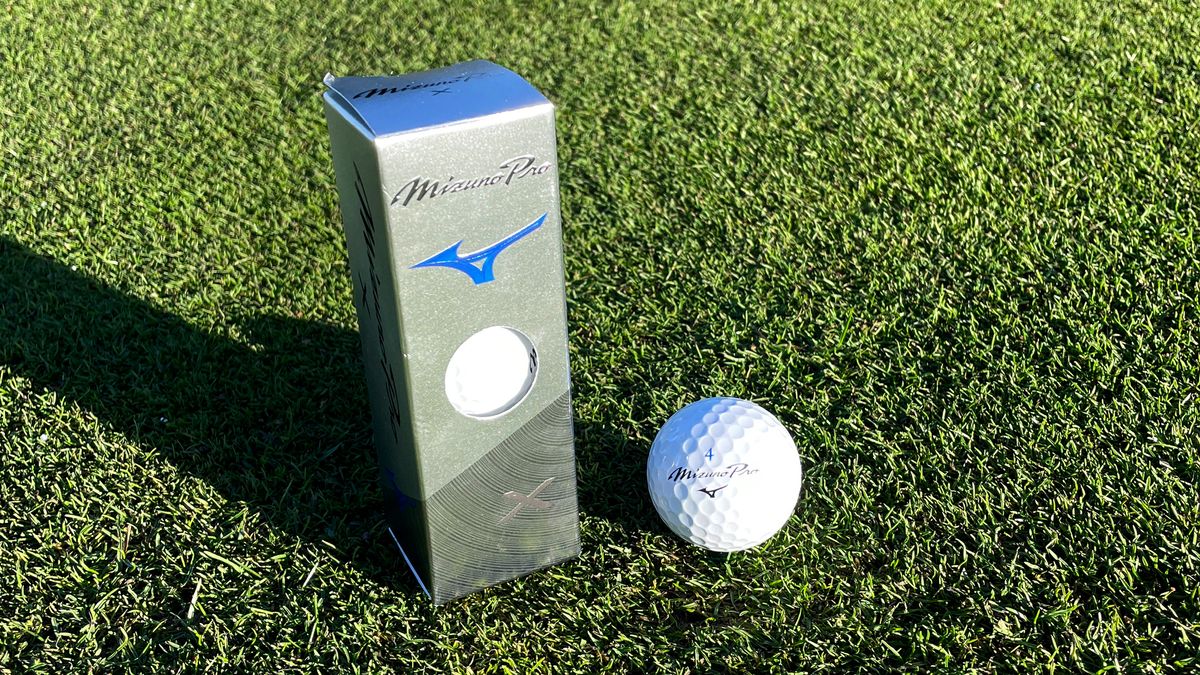Titleist has understandably been the dominant force in pretty much all golf ball categories but especially the premium ball market given its heritage, R&D and popularity on tour. But in recent years other companies have upped their game to become genuine rivals and in the Mizuno Pro X, the Titleist Pro V1 has another worthy contender to fend off.
Think of Mizuno and your mind would likely spring to soft-feeling irons and perhaps forgiving drivers in more recent times but let me tell you right now – with imminent release of the Pro range, Mizuno now makes some of the best golf balls on the market.
The Pro balls replace the RB Tour franchise and boast a new construction that includes a 12 percent thinner urethane cover and a six percent thicker mantle layer, a combination that Mizuno claims significantly enhances ball speed while maintaining a soft, responsive feel.
(Image credit: Future)
Take a ball out of a sleeve for the first time and you see the Mizuno Pro scripting. It’s super cool and carries over from the impressive Mizuno Pro irons, some of the best golf irons around. The Pro X is distinguished from the Pro S golf ball with its blue play number. I also like the arrow sidestamp, which will be useful for those that use a line on their ball for alignment.
To put Mizuno’s claims to the test I took a sleeve over to Peterborough Milton Golf Club to hit drivers, 7-irons and 50-yard pitch shots on the Foresight Sports GCQuad launch monitor before putting the ball in play on the course for multiple competitive rounds. The numbers were frankly astounding.
The three-layer Mizuno Pro X produced driver ball speed of 156.2mph, which was comparable to the recently launched Z-Star Diamond ball I really liked, but because it launched considerably higher with low spin it flew four yards further. It was also longer than the Z-Star XV and seven yards longer than the Titleist 2023 Pro V1x. I noticed more distance on the golf course too – both the new Mizuno Pro balls have a 332 Axial Flow Dimple Design which claims to reduces air resistance for a consistent, stable flight. While it’s hard to properly validate such claims, I was certainly further down the fairway on some holes than I was accustomed to.
But the positives don’t stop there. The Mizuno Pro X was also significantly faster and higher flying with the irons paired mid-to-high spin and a descent angle close to 50 degrees to maximise stopping power. In fact, both the Mizuno Pro balls were up to four yards longer than any of the new Srixon Z-Star balls with a 7-iron in hand. On a 50-yard wedge shot, the Pro X ball provided over 7000rpm of spin, which is by no means market leading but it was 6000 rpm more than the Mizuno Pro S and it’s more than enough to get the ball to check up quickly by the hole when well struck.
The feel of this ball also really impressed me. It manages to be firm but not excessively so, providing a responsive sensation on putts and shorter wedge shots that is noticeably different to the soft Mizuno Pro S ball. It’s very comparable to the Pro V1x if truth be told, which is certainly no bad thing.

(Image credit: Future)
So what’s the catch? I genuinely don’t know if there is one. Is being too cheap a problem? Coming in at £40 or $47.99 a dozen is significantly cheaper than all it’s rivals in the three-piece, premium ball sector but I’m not seeing any trade off in performance or durability. Speaking of which, the cover held up surprisingly well. Even after two rounds on a wet winter course, the outer layer still only has some very minor scuffs on it with no obvious decolorisation.
This could well become one of the most underrated products launched this year or even this decade. With the price of golf balls becoming increasingly more difficult to justify, the Mizuno Pro X provides a more affordable alternative that can compete with, and in some areas outperform, the so-called market leaders. Speaking honestly – the rest of the balls I had have gone straight in my bag and I’d have no issue if I pulled one out for an important round.













